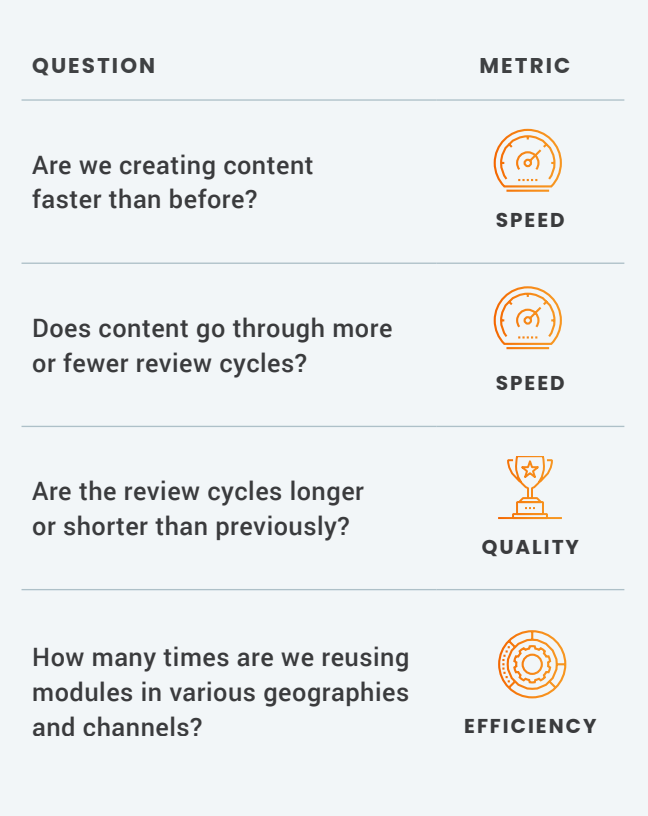White Papers
6 Guidelines for Preparing Teams
to Scale Modular Content
No matter why you join the modular content movement, scaling it requires a change management plan to gauge stakeholders’ readiness and lay the foundation for success. Before creating your first module, use the following six guidelines to pave the way for new modular processes and, potentially, new technology.
By 2025, 50% of biopharma commercial content will be modular, according to The Veeva Executive Content Innovation Council. The draw of modular content varies by company. Still, all that adopt a modular content strategy leap forward from the old approach of creating every asset from scratch.
One vice president of content says, “We were facing an enormous and fastgrowing amount of content that required us to establish new ways of working to achieve our business goals.” She and her team anticipated that a modular approach to content would provide the agility they needed.
BioMarin wanted to analyze content flow to prepare for omnichannel and map a modular strategy. Tom Zito, associate director of global content management operations, says, “We have a chance to re-engineer our content model, configure things around what we want to measure, and to measure right.” His team got the ball rolling by identifying metrics around content reuse and review within and across regions.
No matter why you join the modular content movement, scaling it requires a change management plan to gauge stakeholders’ readiness and lay the foundation for success. Before creating your first module, use the following six guidelines to pave the way for new modular processes and, potentially, new technology.
GUIDELINE 01
Communicate your ‘why’ to promote buy-in
Modular content personalizes HCP engagement, helping them get the right information to patients faster. That powerful message aligns with biopharma’s mission, making it an excellent baseline for stakeholder education and buy-in. When identifying and communicating your why, consider sharing other measurable outcomes of modular content use as well, including its ability to:
- Deliver savings and efficiencies
A modular content approach helps one customer reduce time to marketby more than 50% and boosts content reuse by 40%. - Prepare for a digital model
Estimates reflect that 90% of content will be digital in 2027. Modular’s efficiency lays the foundation for faster content production at scale. - Safeguard regulatory compliance
Using multiple versions of similar content makes it difficult for reps to know what assets to use, risking compliance. Modular content helps avoid version control issues and ensures brand consistency. - Reach HCPs and patients faster
Patient starts are 2.5 times more likely when reps provide content in meetings. Field teams can be more confident sharing content when the messages appeal to an individual HCP on their roster.
It’s never too early to align with stakeholders about the reasons for your initiative. Communicate anticipated roles, potential timelines, and preliminary measures of modular content success from each stakeholder’s point of view. At the organizational level and for senior leaders, connect your proposed modular strategy directly to key business objectives. At the team and individual stakeholder levels, help others embrace change based on department- and role-based goals and motivations.
Remember that you’ll identify and designate change champions within your stakeholder groups as you go.

GUIDELINE 02
Prep MLR teams, especially
Much of the preparation for modular content adoption focuses on medical, legal, and regulatory (MLR). After all, the MLR team is responsible for signing off on the final version of content. Dr. Tim Patel, U.K. medical director at Astellas, says, “There’s a real advantage in having modular content, and medical needs to get involved a lot earlier to get the foundation right.”
Areas of focus in prepping the MLR team for modular content success include:
- Analyzing submission guidelines and revising them as needed for modules
- Ensuring review teams are comfortable reviewing modular content
- Creating regulatory submission examples on how to submit variable and modular promotional content to the FDA compliantly
Partnering with MLR colleagues early in planning for modular content adoption can also drive strategic innovation. One customer evaluated MLR efficiency during a modular content initiative by analyzing reviewer comments in Veeva Vault PromoMats. The goal was to spot trends in materials from partner agencies. For example, a medical team may flag anything from inaccuracies to grammar and spelling mistakes. Analyzing the comments in aggregate helps identify and remedy common hurdles to create accurate content faster.
“There’s a real advantage in having modular content, and medical needs to get involved a lot earlier to get the foundation right.” - Dr. Tim Patel, U.K. Medical Director, Astellas

GUIDELINE 03
Go it alone or choose the right partner
If your organization is weighing its options to use internal resources versus partnering with a third party, know the pros and cons of each path, with some highlighted here.


GUIDELINE 04
Start small and learn fast
Internal change management is often the most challenging hurdle to overcome in any business initiative. It requires alignment across stakeholders on a global level and must also consider local teams’ needs. Therefore, Veeva often recommends a pilot project to start small, learn fast, and then scale rapidly. The vice president of content says, “If you set up the foundations correctly by starting slowly, you can demonstrate modular content’s value, and the path gets much easier.”
Identify an area of the business suited to drive change while limiting disruption or risk to other parts of the organization. For example, consider deploying modular content for a new brand, channel, or indication, as Otsuka Europe did. Doing so eliminates the need to redo a mature product’s long-standing content processes.
To deploy modular content for a more mature brand, start by auditing your existing content. Determine which frequently used messages make sense to ‘modularize.’ Keep in mind, though, that not everything has to be a module — keep a focus on the primary elements where you hope to drive consistency and reuse.
It’s advisable to implement processes (and potential technical changes) to ensure that teams can easily access the modular content library and that the review and distribution processes are modern to reap the benefits of using modular content.
“If you set up the foundations correctly by starting slowly, you can demonstrate modular content’s value, and the path gets much easier.” - Vice President of Content at one biopharma

GUIDELINE 05
Find and focus on efficiency gains
Stakeholders at all levels of your organization will want to know what content stages are most likely to show efficiency gains and the ‘payoff’ of the changes. With modular content, performance improvements will vary within and between biopharmas. For some, the advantage will come in the content creation phase, enabling a centralized production model or bringing some content creation capabilities in-house, thus saving on agency spend. Others will see a more streamlined and linked-in MLR process, team, or both, resulting in getting more personalized content to market faster.
When communicating about anticipated efficiencies gained (and, later in the process, realized advancements), the most critical takeaway is to be transparent: Keep reporting and showing progress and opportunities to improve. To begin thinking about measures, consider that:
The proper measures start with a clear objective
- The factors explicit in the objective are:
- You align it to business goals
- Stakeholders know what success looks like
- You map it to the product phase
- KPIs drive progress and show what’s working:
- Leading indicators show progress
- Impact KPIs show whether the objective is working
Defining and requesting critiques on leading indicators for success and impact opportunities may be beneficial. The input could come from your industry partners, technology provider, and internal stakeholders. At the outset, consider metrics such as:


GUIDELINE 06
Prepare to answer tough questions
Deploying modular may require you to debunk myths and navigate tough questions from internal and external stakeholders, including the following:
Q: Does creating personalized content mean creating more new content?
A: Modular content strategy is a significant departure from creating one-off assets, so strategy leaders should prepare to educate stakeholders and guide them through changes. With planning, you can implement new processes for creating, reviewing, and distributing content with minimal disruption and without jeopardizing compliance. Technology can assist with streamlining reviews, for example, so you don't see a spike in content volume.
Q: Is modular content designed only for global enterprises that have a lot of content?
A: Modular content can benefit an organization of any size if the goals and KPIs align. While large organizations may look to achieve shifts in the content production model to create a large-scale content ‘factory,’ smaller organizations can benefit from the ability to do more with less by creating modular content from their first brand launch.
Faster speed to market, more tailored HCP messaging, streamlined MLR workflows: Modular content’s advantages are made possible through its ability to produce pre-approved content for use across channels and regions. Get ready to launch your modular content change management plan on any scale — from a pilot test to a global brand launch campaign.
Learn how Veeva Business Consulting can help your marketing organization be more agile by delivering actionable data, timely and relevant insights, and content strategy support.